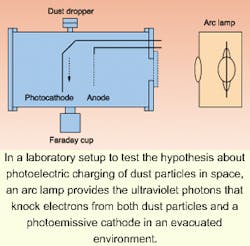PHOTOELECTRIC PHENOMENA: Lab research supports floating dust theory
Researchers at the University of Colorado (Boulder) have experimentally reproduced the photoelectric effect thought to cause floating dust on the moon, on asteroids, and on the rings around planets. Dust particles floating about a meter above the surface of the moon were first observed more than 30 years ago by unmanned NASA spacecraft and later by lunar astronauts.
The lack of an atmosphere on the moon ruled out wind as an explanation for the phenomena, which were subsequently hypothesized as being caused by a photoelectric effect. Ultraviolet (UV) photons hurtling from the Sun were thought to knock electrons off the dust particles and off the moon surface. Excess electrons from the lunar surface gave a negative charge to dust particles at the surface, according to the theory, but the paucity of these photoelectrons above the surface was thought to cause a layer of positively charged dust particles. Repulsed by a positively charged lunar surface just enough to defy the pull of gravity, these dust particles floated as if stirred by an atmospheric wind.
The Colorado researchers tested the hypothesis by using a 1-kW mercury xenon arc lamp to pump UV photons (about 20 µm in wavelength) into a cylindrical aluminum vacuum chamber that was 30 cm in diameter with a vacuum pressure of 4 x 10-7 Torr (see figure).1 The surface of the moon was simulated by a zirconium photocathode (12.5 cm in diameter) and a 15-cm-square nickel-wire anode within the vacuum chamber. Moon dust was simulated by particles of zinc, copper, graphite, and glass 90 to 106 µm in diameter. The particles were released from a dust dropper at the top of the vacuum chamber and received by a Faraday cup at the bottom. With the cathode and anode removed from the chamber, the dust particles exhibited a mean charge of about -4 x 104e. When the cathode and anode were placed in the chamber, however, the UV photons from the arc lamp knocked electrons from the zirconium plate, thereby reversing the polarity of the dust particles to -4 x 104e.
Understanding the photoelectric charging of dust particles under vacuum conditions is expected to be useful in modeling spacecraft environments.
REFERENCE
- A. A. Sickafoose et al., Phys. Rev. Lett. 84(26), 6034 (26 June 2000).
About the Author
Hassaun A. Jones-Bey
Senior Editor and Freelance Writer
Hassaun A. Jones-Bey was a senior editor and then freelance writer for Laser Focus World.
